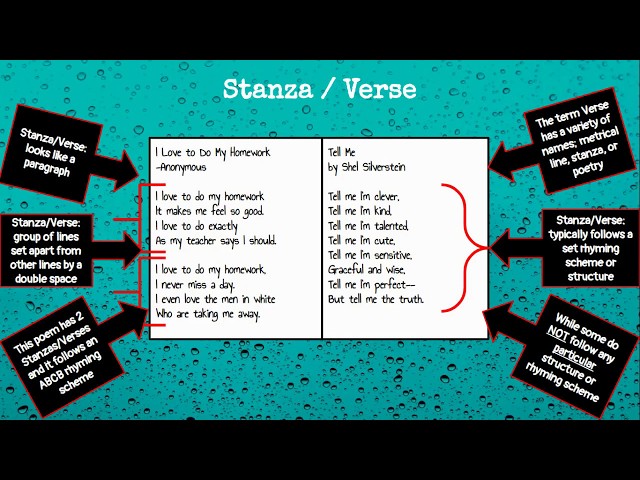Physical Address
304 North Cardinal St.
Dorchester Center, MA 02124
Physical Address
304 North Cardinal St.
Dorchester Center, MA 02124

Contents
When delving into the world of poetry, one cannot ignore the significance of stanzas. Just like paragraphs in prose, stanzas play a crucial role in providing structure, rhythm, and organization to a poem. But what exactly is a stanza in a poem and how does it influence the overall composition? Let’s explore the concept of stanzas in poetry and their various functions.
A stanza is essentially a set of lines grouped together in a poem. These lines are separated to help divide and organize the poem, much like how paragraphs function in prose. Stanzas come in various types, typically defined by the number of lines they contain. Poets use stanzas to shape a poem’s structure, rhythm, shape, and organization.
Stanzas serve both logistical and creative purposes in poetry. They act as a tool for poets to influence how a poem is read and perceived. Here are some key reasons why stanzas are important:
Stanzas are fundamental in providing a poem’s structure. They create a framework by dividing lines into different segments, helping to organize the flow of the poem. For example, Emily Dickinson’s poem “There is another sky” utilizes two stanzas to structure the poem into distinct parts.
Just as paragraphs organize topics in prose, stanzas are used for organization in poetry. Each stanza may explore a different idea or theme, guiding the reader through the poem’s progression. The introduction of a new stanza often signifies a shift in topic or tone within the poem.
Some poets use stanzas to create the visual shape of a poem. By manipulating the arrangement of lines within a stanza, poets can influence the overall shape of the poem on the page. George Herbert’s poem “Easter Wings” is a prime example of how lines within a stanza can be structured to mimic the shape of wings.
Stanzas contribute significantly to the rhythm and meter of a poem. Lines within the same stanza are often read together, creating the intended rhythm of the poem. A break between stanzas can introduce pauses or shifts in the reading, enhancing the overall rhythm of the piece.
Stanzas in poetry come in various forms, each defined by the number of lines and the rhyming pattern used. Let’s delve into some common types of stanza forms:
A couplet is a stanza structure consisting of two lines that typically rhyme. Shakespeare often used couplets to conclude his sonnets, emphasizing key ideas or themes.
A tercet is a stanza made up of three lines. These lines may all rhyme or follow an ABA pattern, as seen in Percy Shelley’s “Ode to the West Wind.”
A quatrain consists of four lines, with the second and fourth lines usually rhyming. Emily Dickinson’s poem “Because I could not stop for Death–” is a notable example of a quatrain structure.
A sestet comprises six lines and is commonly found in the second half of an Italian sonnet. Edgar Allan Poe’s “Annabel Lee” utilizes sestets to convey the narrative of the poem.
An octave is a stanza with eight lines, often found in sonnets. Christina Rossetti’s “Remember” exemplifies the use of an octave with an ABBA ABBA rhyme scheme.
A heterometric stanza features lines of varying lengths, adding a dynamic quality to the poem. Rapper Billy Woods’ song “Spongebob” showcases the use of heterometric structure in poetry.
Lyrics in music also utilize stanzas, akin to poetry. Let’s explore how stanzas are employed in songwriting through the works of renowned lyricists:
Bob Dylan, a celebrated lyricist, incorporates stanzas in his songs to convey emotions and narratives. His song “Standing in the Doorway” showcases the use of different stanza structures to evoke poignant themes.
MF DOOM, known for his intricate rhyme schemes, demonstrates the use of stanzas in his songs to create complex narratives and wordplay. His song “Doomsday” features stanzas with varying line lengths, enhancing the lyrical depth.
Stanzas play a vital role in shaping the structure, rhythm, and organization of a poem. By understanding the various types of stanza forms and their functions, poets can effectively convey their creative concepts through the art of poetry. Whether in traditional verse or modern song lyrics, stanzas remain a cornerstone of poetic expression.